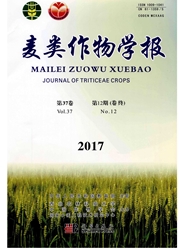

 中文摘要:
中文摘要:
为给小麦变量施氮提供依据,利用冬小麦起身期和拔节期冠层光谱数据,选用反映冬小麦长势信息的优化土壤调节植被指数OSAVI(Optimization of soil-adjusted vegetation index)与CERES-Wheat模型相结合进行变量施肥管理(变量区),以相邻地块常规非变量(均一)施肥区(对照区)为对照,对变量追氮模型的可行性进行探讨,并对变量追肥处理的实际效果进行分析。结果表明,CERES-Wheat模型能较好地反映冬小麦的生长状况,在冬小麦产量预测中,目标产量与实测产量具有良好的一致性。变量施肥区的产量、籽粒蛋白质含量及经济效益均优于对照区,同时变量施肥区的籽粒产量和蛋白质含量的空间变异较对照均有所降低,说明基于高光谱响应与模拟模型的冬小麦变量追氮技术具有一定的理论意义和实用价值。
 英文摘要:
英文摘要:
The aim of this study was to develop the time-specific and time-critical method of variable nitrogen application to overcome the limitations of traditional field sampling methods. Experiments with uniform (CK) and variable rate of nitrogen fertilization were carried out during 2005-2006 on the experimental farm in Beijing (40 10 N, 116 26 E). CERES-Wheat models and spectral index was combined to determine the amount of nitrogen fertilizer recommended for variable rate management. There were significantly linear correlations between the leaf area index (LAI) measured and grain yield with the simulated ones. The result showed that the CERES-Wheat model can be used to predict the state and biophysical variables of wheat. The grain yield and grain protein content were measured among the CK and variable rate fertilizer treatments. It indicated that variable rate fertilization increased grain yield and grain protein content, and it did reduce the variability of them. Economical benefits of fertilization in variable rate application were better than those in CK.
 同期刊论文项目
同期刊论文项目
 同项目期刊论文
同项目期刊论文
 期刊信息
期刊信息
